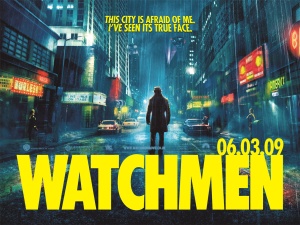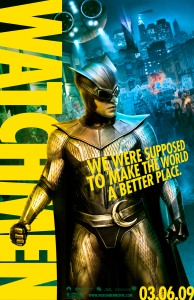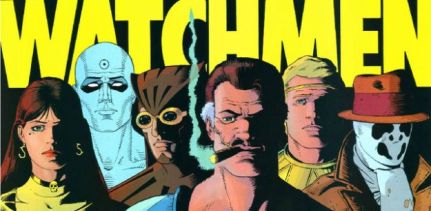1) Book Analysis: Watchmen, a 12-part series of graphic novels written by Alan Moore, takes an untraditional route in describing the escapades of caped crime-fighters. In contrast to the typical stories involving superheroes, The “Watchmen”, as they are called, are so flawed at times in the story it becomes difficult to differentiate these supposed “heroes” from the villains they are supposedly pursuing/thwarting. The setting in the story is on American soil during the mid-1980’s but also includes events that’s had previously occurred such as those involving the earlier counterparts of the main characters during the 1940’s ranging all the way up to the Vietnam War; a conflict that these characters play a paramount role. Themes explored within Moore’s story involve “realism” in the sense that the entire narrative involves how the heroes of fiction would fare in a real, fallible world with real, fallible people; them themselves exhibiting the latter of the two traits. The corruption and degradation is also a very pronounced theme throughout as each hero is shown to have to cope with his/her demons to a degree that often brings the nobility of their societal roles into question.
 2) Film Analysis:In 2009, Alan Moore’s original comic series was translated onto the silver-screen under the same name. Watchmen, as directed by Zack Snyder, stars a cast including Jeffrey Dean Morgan and Jackie Earle Haley and takes place in the midst of the Cold War, as does the comic, in which tensions between the US and Soviet Union have been exacerbated by the presence of the “Watchmen”, most notably Dr. Manhattan who holds at his fingertips the power to annihilate entire cities; a power he gained from a freak accident in his prior work as a physicist. The film preserves the themes and conflicts of the original comic and showcases how even the most admirable hero can fall prey to the corruption that exists in a fallible world. Snyder was sure to make use of the darkness in each of the settings filmed. Each scene, whether it be in the urban jungle of New York City, or the penthouse apartment of one of the Watchmen, was arranged and filmed using very muted colors which gave each locale a certain taint and coldness; an appropriate effect considering the story.
2) Film Analysis:In 2009, Alan Moore’s original comic series was translated onto the silver-screen under the same name. Watchmen, as directed by Zack Snyder, stars a cast including Jeffrey Dean Morgan and Jackie Earle Haley and takes place in the midst of the Cold War, as does the comic, in which tensions between the US and Soviet Union have been exacerbated by the presence of the “Watchmen”, most notably Dr. Manhattan who holds at his fingertips the power to annihilate entire cities; a power he gained from a freak accident in his prior work as a physicist. The film preserves the themes and conflicts of the original comic and showcases how even the most admirable hero can fall prey to the corruption that exists in a fallible world. Snyder was sure to make use of the darkness in each of the settings filmed. Each scene, whether it be in the urban jungle of New York City, or the penthouse apartment of one of the Watchmen, was arranged and filmed using very muted colors which gave each locale a certain taint and coldness; an appropriate effect considering the story.
3) Adaptation Analysis:Despite Alan Moore’s aversion to film adaptations of comics or even literatur e as a whole, Zack Snyder’s film proved to effectively translate Moore’s original story to a Hollywood audience. The themes of “purity corrupted” and “the futility of honor in the real world” remain intact, as do the characters themselves or more notably their flaws as each of them is shown to have significant similarities to the common citizens they protect and even the “villains” they’ve faced. The largest barrier in the adaptation which gained it some scorn from fans of the original series was its time restrictions which prevented in from delving deeper into key character development and, in some cases, certain events occur that seem to assume the audience has either a) prior knowledge of the story/characters or b) could decipher some of Moore’s rather complex story-elements from nothing but their own cognitive abilities.
e as a whole, Zack Snyder’s film proved to effectively translate Moore’s original story to a Hollywood audience. The themes of “purity corrupted” and “the futility of honor in the real world” remain intact, as do the characters themselves or more notably their flaws as each of them is shown to have significant similarities to the common citizens they protect and even the “villains” they’ve faced. The largest barrier in the adaptation which gained it some scorn from fans of the original series was its time restrictions which prevented in from delving deeper into key character development and, in some cases, certain events occur that seem to assume the audience has either a) prior knowledge of the story/characters or b) could decipher some of Moore’s rather complex story-elements from nothing but their own cognitive abilities.
4) Online Sources:
“How Superheroes Fade”
- A blogpost that discusses Moore’s theme of “fallen heroes” at length. This blog post is important because it provides details that would be missed by those unfamiliar with the original series. The blog begins with a plot summary of Moore’s original story which elaborates on details that were merely alluded to in the film such as the parallel narrative: The Black Freighter. He then goes further into what Moore originally intended Watchmen to be in the realm of comics.
http://jaiarjun.blogspot.com/2006/06/how-superheroes-fade-alan-moores.html
“Watchmen Interview: Director Zack Snyder”
- An interview conducted between Film.com’s Cole Haddon and director Zack Snyder where they discuss influences on his filming, casting, and musical choices for the movie.
http://www.film.com/movies/watchmen-interview-director-zack-snyder
Watchmen & 300 Interview with director Zack Snyder
- An interview with the director where he discusses the criticisms of the film.
5) Critical Argument:
In the film, the Comedian says repeatedly: “It’s a joke!” How is this an expression of the Comedian’s personality? How is this an expression of nihilism?
During the Comedian’s assassination scene, his last words are “it’s a joke!” as he finds himself beaten, bruised, and bloody in the hands of his assailant before being tossed to his death and such a line may seem to just be following the “comedian” theme in which he never seems to take anything very seriously, but I believe it showcases his nihilism and rather neurotic nature than his humor. This “joke” he was referring to was likely the world that the Watchmen believe that they operate in as opposed to the actual world. In other words, as evidence by his rant to Ozymandias before torching his map, he does not believe the world operates in a manner befitting justice or evil, or black and white as Rorschach would like to believe. Instead, he believes in cosmic randomness where nothing occurs for a greater reason and forces such as good and evil are mere sentiment without evidence. In this, the world itself, as seen by anyone attempting to achieve “justice” in the world is the grandest of jokes to the comedian.

I enjoyed reading your critical argument. I think the comedian looks at it as a joke to highlight his dark nature. If he truly finds something as dark and serious as that, it will only highlight how neurotic and crazy he is.
LikeLike
Sizana, congratulations for being one of the few who got a perfect score on the blog response post assignment. I appreciate all your contributions to the class. 10/10. Joseph Byrne. ENGL329B.
LikeLike